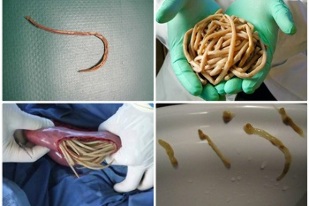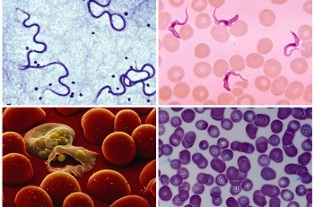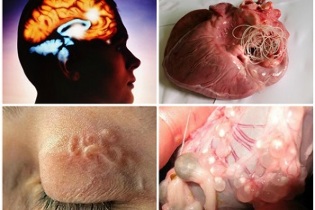There is a risk of getting infected with worms without leaving your home. A variety of helminths are available on household items, banknotes, crockery, food, and drinking water.
Parasites enter the human body in a convenient way for them: they can enter through the digestive system with food, water, through dirty hands or with insect bites.
Furthermore, helminths affect certain internal organs, use human body resources, cause mechanical damage and actively reproduce. Their vital process is accompanied by unpleasant and often dangerous symptoms and damage to various organs.
How to recognize intestinal worms

Intestinal helminthiases unite a group of diseases caused by worms of various kinds. Often, ascariasis (ringworm), enterobiasis (cream worm), mine worm disease (mineworm) can be detected. This parasite lives in the lumen of the human intestine, eats its contents, and its presence can be suspected by a number of characteristic symptoms:
- Dramatic weight loss without altering diet and physical activity. Intestinal group helminths use the human body's nutrients as a source of energy for growth and reproduction, and their tools for anchoring in the intestine (suckers, hooks) injure its walls and interfere with the absorption of trace element residues.
- Pain in the abdomen, navel, itching in the rectum caused by the movement of worms, mechanical damage that causes it, as well as the release of larvae or adults from the body to the external environment.
- Various digestive disorders: diarrhea or constipation, bloating, presence of mucus, foam or blood in the stool, nausea, vomiting. In some cases, adult parasites can be found in feces.
- The human body can respond to the appearance of parasites with allergic reactions, the phenomenon of intoxication, caused by the waste of helminths. More often this is indicated by itching on the skin, redness in certain areas, rashes (vesicles, blisters of different sizes).
Diagnosis of intestinal helminthiasis includes stool examination, clinical and biochemical blood tests (eosinophilia, leukocytosis), and, if necessary, body ultrasound data.
Signs of parasites in the liver
A large amount of nutrients accumulate in the human liver, and there is also a strong blood circulation, which is easily used for parasites. Common hepatic helminthiasis: fascioliasis, opisthorchiasis, dicroceliosis, caused by worms of the hepatic flux group.
You can recognize it by certain features:

- Acute pain in the right hypochondrium is caused by the mechanical effects of helminths. Thus, echinococcus forms cysts in organ tissue, provoking the development of inflammatory processes or even necrosis.
- Adult worms (ringworms) can block the bile ducts, as bile outflow is disrupted, the digestive process in the body is difficult, and patients have signs of jaundice. A person's mucous membranes can acquire a yellow color, and with the development of pathology, the skin also becomes a stain.
- Symptoms of nonspecific parasites will be deterioration of the general condition of the body, weight loss, nausea, lethargy.
To clarify the diagnosis, they donate blood for analysis. Leukocytosis, eosinophilia are detected, and biochemical tests will show increased liver enzyme activity (ALT, AST). During the ultrasound, liver damage will be visible in the body: enlargement, inflammation, and in some cases there are parasitic cysts.
What indicates the presence of pulmonary helminths
Some parasites (ringworm, toxoplasma, echinococcus, tsenur) can enter the gastrointestinal tract into the lungs of a person with blood or lymph flow. They multiply in the alveoli, making breathing difficult, and some species (single-space echinococcus) form cysts, damaging organ structure.
It is difficult to determine the presence of parasites in the lungs, as the symptoms are similar to the manifestations of viral and non-infectious respiratory diseases (bronchitis, ARVI). Cough, shortness of breath, chest pain, fever indicate the need for additional examination of the patient's body.
For the diagnosis of pulmonary helminthiasis, the X-ray method will be the most informative. The picture will show wounds on the human body caused by echinococcus (cyst) and bovine tapeworm (fibrous formation), which then need to be distinguished from neoplasms, cysts of various etiologies and pneumonia.
Blood Parasites

Unicellular protozoa worms can be found in the lumen of vessels. Babesias, plasmodia (plasmodium malaria), trypanosomes, microfilariae, schistosomes cause dangerous diseases that pose a threat to human life.
Destroys shaped elements, they disrupt the process of energy metabolism in the body and restrict the supply of nutrients to organs and tissues.
In most cases, human infections occur after being bitten by insects or fleas. After some time, the symptoms of anemia develop in the body: pale, and then cyanosis of the mucous membranes, dizziness, sudden weight loss and deterioration of health. Without timely medical treatment, blood parasites can pose a serious threat to human life.
Diagnostics involves microscopic examination of the blood, where you can find unicellular parasites and destroyed erythrocytes, as well as determine the type of worm. Long-term treatment, performed immobilically under the supervision of a qualified physician.
Unusual Parasite Habitat
Some types of helminths can penetrate into the human heart, subcutaneous tissue (dirofilariae), brain and spinal cord (cysticercus, echinococcus). You can be infected not only in exotic countries, but also when eating common foods that have not been treated with heat, and pets can be carriers. Signs of aggression depend on the degree of damage to a particular organ.
In the brain, worms can form cysts, fibrous formations that cause nerve phenomena.

Unexplained etiological headaches, tremors (tremors) of the extremities, changes in tactile sensitivity, impaired coordination of movements, impaired hearing and sharp vision - signs of invasive development depend on the location of the worms and their larvae.
Adult parasites can be seen visually under the skin, usually accompanied by itching sensations and tingling, as well as in the eyes, ear canals and other places.
What to do if the signs of a worm attack are noticed
Parasitic etiological diseases are treated under medical supervision after all necessary examinations and determination of parasitic types. Prescribe anthelmintic drugs with a narrow or broad spectrum of action, carry out remedial and symptomatic therapy, promote the removal of worms from the body. In some cases, surgery is indicated.
The prognosis for most diseases is better with the onset of treatment on time. If you delay a visit to the doctor or start taking your own medication, the healing process can be delayed, and many types of parasites can damage vital organs or systems, or even cause death.



























